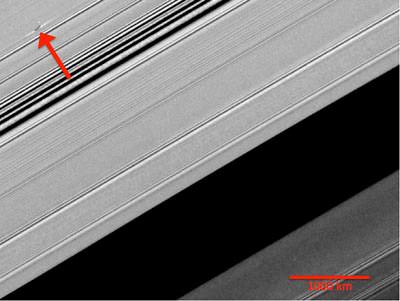Scientists for NASA’s Cassini mission noticed some weird-looking propeller-like shapes in the outer edge of Saturn’s A ring. What could be creating these unusual contours? A closer look revealed they were being formed by dozens of moving moonlets. Normally, these kilometer-sized moons would have been almost impossible to see, since they are embedded within the rings. “However, their presence is betrayed by the large tell-tale ‘propeller’ structures they generate in the ring material on either side of them,” said Carolyn Porco, leader of the Cassini imaging team, and co-author on a new paper on these propeller moons. In an email, Porco said similar features had been seen earlier in other locations in Saturn’s rings, but were “much smaller, harder to see, and so numerous that there was no hope of following any one of them. The new propellers, and the moonlets that create them, are some ten times larger and much easier to identify and follow from image to image and year to year.”
[/caption]
The team said the ability to watch as the embedded moons’ orbits evolve over time could give scientists valuable new clues about how planets form and grow around stars in young solar systems.
“What is outstanding about these new findings is the insight they ultimately will provide into the early stages of solar system formation,” said Porco, “when growing planets become large enough to open gaps in the ring material around them and ultimately truncate their own growth.”
The scientists have tracked eleven of these moons since 2006. Most are between one and several kilometers in diameter, too small to be imaged directly by Cassini’s cameras, but are only distinguishable by the unique double-armed propeller features.
The area in the middle of Saturn’s outermost dense A ring is now known as the “propeller belts,” and the new moonlets have been given appropriate names.
“You may find it amusing that these large propellers have unofficially been named after famous aviators,” Porco said. “Those flight enthusiasts among you will recognize Bleriot, Earhart, Santos-Dumont, and others.”
Cassini caught sight of Blériot (named after a French aviator) more than 100 times, allowing the researchers to map its path in detail. The propeller shape it created is several thousand kilometers long, or half the distance across the continental United States.
“You would expect any object that’s just orbiting Saturn on its own should stay in a constant path,” said lead author Matthew Tiscareno from Cornell University. “What we actually see is that the orbits are changing.”
The most likely explanation, he said, is that the moons are actually interacting with the disk: exchanging angular momentum with the ring particles around them either through gravity or by direct collisions.
Still, other explanations, like resonant interactions with more distant moons, have not been ruled out as causes.
Scientists will be keeping an eye on these wandering little moons in order to figure out if the disk itself is driving the changes, similar to the interactions that occur in young solar systems. If it is, Tiscareno said, this would be the first time such a measurement has been made directly.


<>
… or the largest moon in the Saturnian system except for Titan?! I think there’s an error there. Maybe the visible propellor disturbance is that large even though the moon that causes it is much smaller?
(I won’t even mention the use of “continental” when “contiguous” is probably meant.)
“Oh, drat these computers. They’re so naughty and so complex, I could pinch them.” The part in angle brackets was a quotation from the article to give context. And I can’t seem to edit it, so I want to repost:
“The largest of these propeller moons, Blériot, (named after a French aviator) is several thousand kilometers long, or half the distance across the continental United States.”
… or the largest moon in the Saturnian system except for Titan?! I think there’s an error there. Maybe the visible propellor disturbance is that large even though the moon that causes it is much smaller?
(I won’t even mention the use of “continental” when “contiguous” is probably meant.)
Tim – You’re right, the propeller object is that big, not the moon.
“… generate in the ring material on either side of them…or half the distance across the continental United States.” said Carolyn Porco.
WOWIEnow ~ Gravitational or electrodynamic? Both? Lemme guess, the leading edge is positively charged and the trailing negative? Any polarization showing that? My first impulse is to say definitely gravitational. But then, how about E/M fields generated by cold plasma created as the moon plows thru the ring material? Large tribo-electric currents might be generated in the ultra cold superconducting charged particles…?
Mass and size of Blériot be good to know…
@ Aqua,
When you hear hoof-beats, think of horses, not zebras…
Considering that the ring system is an elegant example of complex gravitational effects, I would _never_ go “EU for the win!” from seeing some phenomena there.
It reminds of people seeing a landslide and go “hey, Earth magnetic field!” :-~
Continental US is indeed the correct word.
States may be contiguous, yet not stretch continentally.
The Continental US is the 48 “lower” states. (approx. 3000 miles.)
IV3man@lg and Torbjorn Larsson OM – Ahem.. the experts have spoken!
Try this instead: http://www.springerlink.com/content/h7847167150735g2/
Or this: http://adsabs.harvard.edu/abs/1982JGR….87.3449M
Or this: http://www.nowpublic.com/tech-biz/has-electrodynamics-solved-mystery-saturns-dual-hotspots
A quote from the above: “Thornhill and other forward thinking men like Don Scott, Eric Lerner, Halton Arp and many more have faced rabid academic and mainstream media bias wherein their work is either ignored (because it is anathema to the gravity only based cosmological model that reigns like a world religion today) or ridiculed. Beyond ridicule; which makes this newsworthy to say for the public good; men like Halton Arp have been ostracized, punished and forbidden access to research tools and funding for having the audacity to report the truth! “